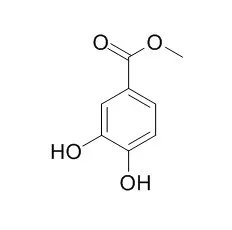| Structure Identification: |
| J Agric Food Chem. 2008 Jul 9;56(13):4928-36. | | Reduction kinetics of the antiradical probe 2,2-diphenyl-1-picrylhydrazyl in methanol and acetonitrile by the antiradical activity of protocatechuic acid and protocatechuic acid methyl ester.[Pubmed: 18547047] | This work evaluates the reduction kinetics of the antiradical probe 2,2-diphenyl-1-picrylhydrazyl (DPPH (*)) in methanol and acetonitrile by the antiradical activity of protocatechuic acid (3,4-dihydroxybenzoic acid, 1) and Protocatechuic acid methyl ester ( 2).
METHODS AND RESULTS:
The reduction kinetics of DPPH (*) in both solvents by the antiradical activity of the p-catechol group in 2 is regular, that is, coincide with the proposed standard kinetic model for the reduction kinetics of DPPH (*) by the antiradical activity of an isolated p-catechol group. Therefore, the antiradical activity of 2 experimentally exhibits two rate-two stoichiometric constants in acetonitrile and three rate--three stoichiometric constants in methanol. In contrast, the reduction kinetics of DPPH (*) in both solvents by the antiradical activity of the p-catechol group in 1 is perturbed, that is, deviate from the proposed standard kinetic model.
CONCLUSIONS:
The deviations arise from the presence of the reactive carboxylic acid function which, in methanol, induces an additional reversible side reaction and, in acetonitrile, turns an irreversible reaction reversible, thus modifying the otherwise regular reduction kinetics of DPPH (*) by the antiradical activity of the p-catechol group in 1. On the other hand, the approximated theoretical kinetic equation that applies for those p-catechol groups whose reduction kinetics is regular and that experimentally exhibit three rate--three stoichiometric constants has been derived and used for fitting. |
|






 Cell. 2018 Jan 11;172(1-2):249-261.e12. doi: 10.1016/j.cell.2017.12.019.IF=36.216(2019)
Cell. 2018 Jan 11;172(1-2):249-261.e12. doi: 10.1016/j.cell.2017.12.019.IF=36.216(2019) Cell Metab. 2020 Mar 3;31(3):534-548.e5. doi: 10.1016/j.cmet.2020.01.002.IF=22.415(2019)
Cell Metab. 2020 Mar 3;31(3):534-548.e5. doi: 10.1016/j.cmet.2020.01.002.IF=22.415(2019) Mol Cell. 2017 Nov 16;68(4):673-685.e6. doi: 10.1016/j.molcel.2017.10.022.IF=14.548(2019)
Mol Cell. 2017 Nov 16;68(4):673-685.e6. doi: 10.1016/j.molcel.2017.10.022.IF=14.548(2019)